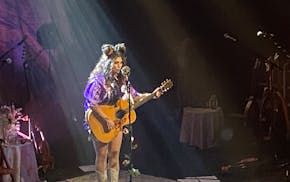Curling — long a niche sport in the Twin Cities with a small but devoted following — is spreading across the metro area, with hundreds of new aficionados at one of four new facilities that have sprung up in the past five years.
Dakota Curling opened in late January in a former grocery store in downtown Lakeville. Lakeville's two high schools appear to be the first metro-area schools to add curling as an independent club sport; the teams will begin play this winter, both intramurally and against other youth teams.
Chaska's $18 million municipal Curling Center, which is adjacent to an event center and pub, has gone from an unconventional idea to a success story in the year since it opened. The Four Seasons Curling Club at Fogerty Arena in Blaine was designated an official Olympic training site in 2015, the only one in the United States.
"It's certainly exploding with growth around the metro, more so than anywhere in the world that I know of," said Jeff Isaacson, a two-time Olympic curler who manages the Chaska Curling Center.
And there's talk on the street that groups in Rogers, Woodbury, Plymouth and St. Louis Park also want to build their own curling centers.
The St. Paul Curling Club, which dates back to the 19th century and boasts one of the country's biggest rosters with 1,100 members, long has made the Twin Cities a center for organized curling. The sport is best known in Canada and on the Iron Range but its popularity is growing across the United States, Isaacson said, because it's challenging yet accessible for all ages and abilities.
It became an Olympic sport in 1998 and, four years later, NBC ran more than 50 hours of Olympic curling on TV, said Rick Patzke, CEO of USA Curling, the sport's national association.
Once they've tried it, players keep coming back, hooked by the sport's social nature and the camaraderie it creates.
"It's been kind of a coming-out for curling since the 2002 Olympics," Patzke said. "In Minnesota, what's really surprising is the number of dedicated curling facilities."
The new golf or bowling?
In curling, two teams of four players each slide a 42-pound granite stone down a 15-foot-wide sheet of ice toward the target, called a house. Each team tries to get its rock closer to the center of the house, which is the size of a dinner plate. As the rock travels, players must judge whether to furiously sweep back and forth in front of it, using heat and friction to direct its path.
The sport caught on with TV viewers during the Olympics because of amusing commentators and the fact that players wear microphones, so their comments can be heard in real time. It's a sport where spectators can get up to speed on what's happening quickly, Patzke said. And it's an indoor winter sport, so it never gets snowed out.
Because it involves strategy and finesse, curling draws comparisons to golf and bowling. "It doesn't take long to learn the game, but it's a challenge to do it well," said Jeff Kennedy, who curls at both the Chaska and Dakota facilities.
Lakeville North junior Levi Rosenthal and several friends lobbied to bring curling to Lakeville North and South high schools as a coed club sport this year. About 15 kids have signed up, Rosenthal said. They will play high school students throughout the region and each other, and Dakota Curling will be their home base.
Rosenthal likes that the sport is competitive yet friendly, with an emphasis on etiquette.
"In hockey, you're not going up to your opponent and telling them how they can get better," he said. "This is more of a gentleman's game, and I think that's fun."
St. Paul led the way
Wisconsin has the largest concentration of curlers in the U.S., Patzke said, but Minnesota isn't far behind. Wisconsin has 27 clubs that belong to the national association with 4,660 members, while Minnesota has 22 clubs and 4,237 members. There are 2,000 to 3,000 curlers nationally in clubs that aren't association members.
Because of demand, the St. Paul Curling Club helped start the Frogtown Curling Club in 2012, said Scott Clasen, general manager of the St. Paul club. A year later, Blaine curlers created Four Seasons. The Chaska Curling Center debuted in December 2015 and already has 1,200 members, though it isn't affiliated with the national association, Isaacson said.
Clasen said time will tell whether curling's popularity lasts but that none of the clubs have lost members as facilities were built. There's camaraderie among clubs, Clasen said, and some people belong to more than one.
The Dakota Curling Club began in 2006, playing at the Burnsville Ice Arena. But the club couldn't grow there, said Darcy Ellarby, club president. The group was also "really interested in getting better control over the ice" in terms of its temperature and water quality, which can change how the rock slides.
Dakota Curling's new facility, built in a former grocery store, required a $1 million investment. The landlord paid $750,000 toward renovation, and the nonprofit club used fundraising, reserve funds and a loan to buy $250,000 worth of ice-making equipment. The club is leasing the space for 20 years.
Membership has shot up from 125 to 400 since the new facility opened, Ellarby said, and the winter session is nearly full. Friday night mixed league games have become a popular date night for couples.
"I wouldn't be surprised if, in the next 10 years, there are curling facilities in the extreme east and west of the metro," Ellarby said. "We could have more than five."
Erin Adler • 612-673-1781
Retrial of Harvey Weinstein unlikely to occur soon, if ever, experts say

Harvey Weinstein hospitalized after his return to New York from upstate prison

Review: Sierra Ferrell wows sold-out First Avenue with her refreshingly quirky country sounds

